Release Date :
Reference Number :
Issue No. 11, Series of 2017
Approved building permits in the first quarter of 2017 totaled to 2,870. Of the total construction projects, 1,930 or 67.2 percent were residential-type buildings, 400 or 13.9 percent were nonresidential and 540 or 18.8 percent were additions, alterations and repair constructions.
Figure 1 shows the distribution of construction projects by type for the first quarter of 2017.
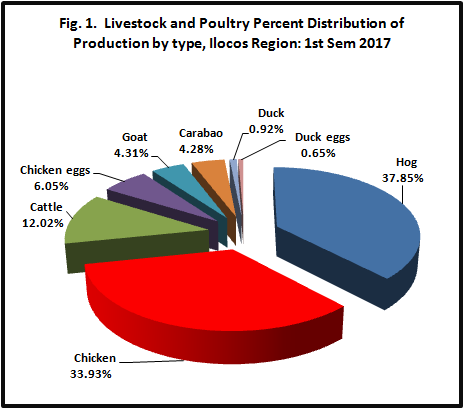
Among the provinces in Region I, the highest number of construction projects was recorded in Ilocos Norte with 1,037 accounting to 36.1 percent of the total construction projects, followed by Pangasinan with 798 (27.8 percent), Ilocos Sur with 571 (19.9 percent) and La Union with 464 (16.2 percent).
Figure 2 shows the distribution of construction projects by province for the first quarter of 2017.
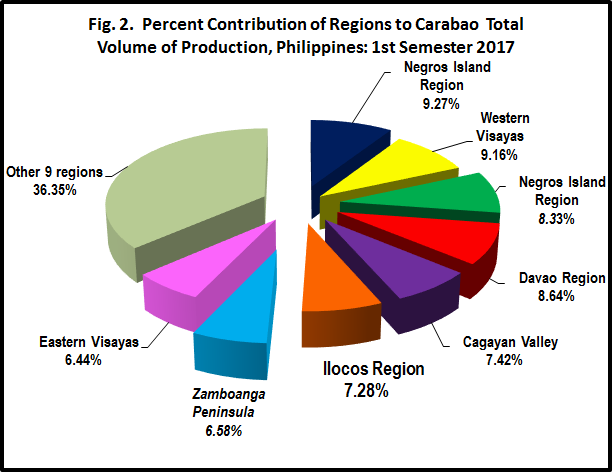
Total value of construction amounts to ₱3.0 billion
Total value of construction from approved building permits for the first quarter of 2017 was recorded at ₱3.0 billion.
By type of construction projects, value of residential buildings amounted to ₱1.8 billion, while nonresidential construction buildings was valued at ₱919.8 million for the first quarter of 2017.
Combined value of constructions for additions, alterations and repairs of existing structures was estimated at ₱288.8 million.
Figure 3 displays the aggregate value of construction by type for the first quarter of 2017.
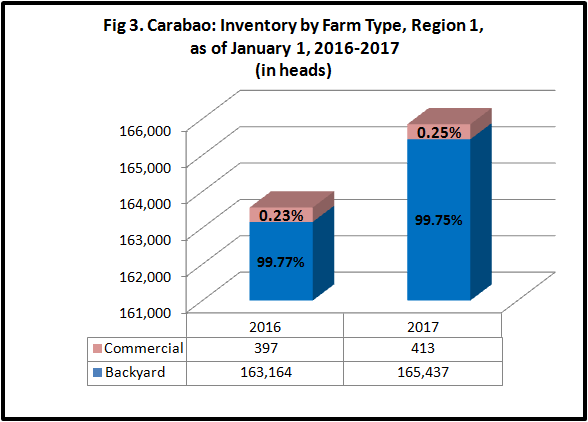
Average cost per square meter of residential building construction is ₱9,095
Total value of construction for residential buildings was ₱1.8 billion with a total floor area of 202,204 square meters, translating to an average cost of ₱9,095 per square meter.
Among the residential constructions, single houses recorded the bulk of the projects with 1,882 accounting for 97.5 percent of the total. Total value of construction for this type reached ₱1.7 billion covering a total floor area of 192,028 square meters, translating to an average cost of ₱9,112 per square meter. Apartment/accessoria ranked far second with 39 construction projects representing 2.0 percent of the total residential construction. This type of residential building had an estimated construction value of ₱79.9 million with a total floor area of 9,180 square meters, translating to an average cost of ₱8,706 per square meter.
Duplex houses recorded a total of three (3) construction projects representing 0.2 percent of the total residential construction. Total construction value for this type amounted to ₱5.0 million and a total floor area of 412 square meters or an average cost of ₱12,117 per square meter.
Figure 4 shows the number and value of residential construction by type for the first quarter 2017.
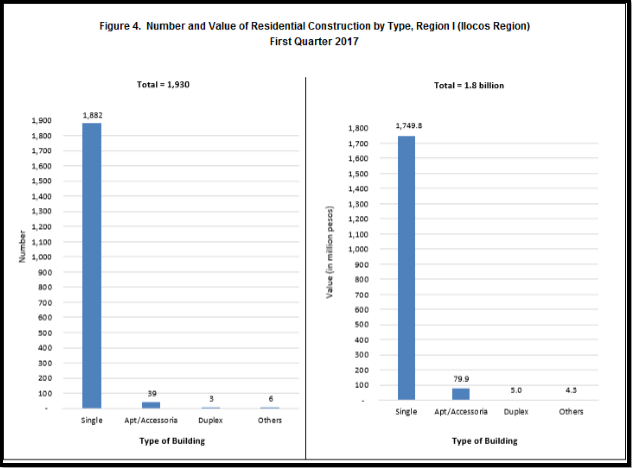
Commercial building dominates non-residential construction projects
The total value of non-residential building constructions in the region reached ₱919.8 million with a total floor area of 114,024 square meters reflecting an average cost of ₱8,066 per square meter.
Commercial buildings had the highest number with 267 construction projects or 68.8 percent of the total non-residential constructions. Value of construction for this type was estimated at ₱459.5 million covering a total floor area of 52,861 square meters or an average cost of ₱8,692 per square meter.
Institutional buildings distantly followed with 63 construction projects or 15.8 percent of the total non-residential construction with a total construction value of ₱293.1 million and a total floor area of 31,199 square meters or an average cost of ₱9,395 per square meter.
Agricultural buildings ranked third with 33 construction projects. It comprised 8.3 percent of the total non-residential building constructions with construction value of ₱109.9 million with a total floor area of 19,908 square meters or an average cost of ₱5,522 per square meter.
Industrial buildings closely followed with 32 construction projects or 8.0 percent of the total nonresidential building construction. It has a total construction value of ₱54.1 million and with a total floor area of 10,056 sq.m. or an average cost of ₱ 5,384 per square meter.
Figure 5 shows the number and value of non-residential construction by type for the first quarter 2017.
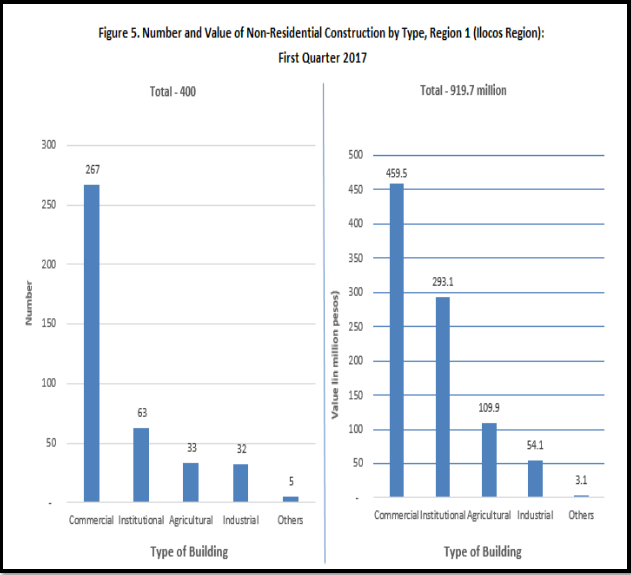
TECHNICAL NOTES ON CONSTRUCTION STATISTICS FROM APPROVED BUILDING PERMITS
Introduction
This Special Release presents the preliminary data on construction statistics from approved building permits for the first quarter of 2017, generated 60 days after the reference quarter.
Scope and Coverage
Construction statistics from approved building permits relate to administrative-based data on new constructions and additions, alterations and repairs of existing residential and non-residential buildings and other structures proposed to be constructed in all cities/municipalities nationwide in a specific period.
Source of Information
Construction statistics are compiled by the Philippines Statistics Authority (PSA) from the copies of original application forms of approved building permits as well as from the demolition permits collected every month by PSA field personnel from the Offices of Local Building Officials (LBOs) nationwide.
LIMITATIONS:
1. Data on private building constructions refer to those proposed to be constructed during the reference period and not to construction work completed during the reference period.
2. The completeness of the number of building permits collected relies on the approval of applications filed with the Office of Local Building Officials (LBOs). Hence, private building constructions without approved building permits are excluded from the tabulation of data.
Geographic Classification
Private building constructions are classified and presented by geographic area using the Philippine Standard Geographic Classification (PSGC). The PSGC contains the latest updates on the official number of provinces of Region 1.
The geographic codes are in accordance with NSCB Resolution No. 3, Series of 2005 that approved the PSGC.
Industry Classification
Construction statistics utilizes the amended 1994 Philippine Standard Industrial Classification (PSIC) to classify the main activity through the use or type of occupancy of the building.
Definitions of Terms:
Building permit is a written authorization granted by the Local Building Official (LBO) to an applicant allowing him to proceed with the construction of a specific project after plans, specifications and other pertinent documents have been found to be in conformity with the National Building Code (PD 1096).
Building refers to any independent, free-standing structure comprised of one or more rooms or other spaces, covered by a roof and enclosed with external walls or dividing walls, which extend from the foundation to the roof.
Construction refers to all on-site work done from site preparation, excavation, foundation, assembly of all the components and installation of utilities and equipment of buildings/structures.
Residential buildings are buildings for which its major parts or more than half of its gross floor area is built for dwelling purposes. This type of building can be of the single type, duplex, an apartment and/or accessoria and residential condominium.
Single house is a complete structure intended for a single family or household, i.e. bungalow, 2storey house, nipa hut.
Duplex house is a structure intended for two households, with complete living facilities for each; it is a single structure divided into two dwelling units by a wall extending from the floor to the ceiling.
Apartment is a structure, usually of two storeys, made up of independent living quarters, with independent entrances from internal walls and courts.
Accessoria is a one or two-floor structure divided into several dwelling units, each dwelling unit having its own separate entrance from the outside.
Residential condominium is a structure, usually of several storeys, consisting of multiple dwelling units.
Other residential constructions consist of school or company staff houses, and living quarters for drivers and maids and guardhouses.
Non-residential buildings include these type of buildings: Commercial, Industrial, Agricultural and Institutional buildings.
Commercial buildings refer to office buildings and all buildings which are intended for use primarily in wholesale, retail and service trades; i.e. stores, hotels, restaurants, banks, disco houses, etc.
Industrial buildings are buildings that are used to house the production, assembly and warehousing activities of industrial establishments; i.e. factories, plants, mills, repair shops, machine shops, printing press, storage plant, electric generating plants.
Institutional buildings are buildings which are primarily engaged in providing educational instructions and hospital/health care; ports, airports and other government buildings; i.e. school, museums, libraries, sanitaria, churches, hospitals.
Agricultural buildings are buildings used to house livestocks, plants and agricultural products such as barns, poultry houses, piggeries, stables, greenhouses and grain mills.
Other non-building constructions include cemetery structures, street furniture, waiting sheds, communication towers, etc.
Addition refers to any new construction which increases the height or area of an existing building/structure.
Alteration is a construction in a building/structure involving changes in the materials used, partitioning and location/size of openings, structural parts, existing utilities and equipment but does not increase the overall area thereof.
Repair is a remedial work done on any damaged or deteriorated portion/s of a building/structure to restore its original condition.
Demolition refers to the systematic dismantling or destruction of a building/structure or in part.
Street furnitures are street structures which consist of monuments, waiting sheds, benches, plant boxes, lampposts, electric poles and telephone poles.
Floor area of building refers to the sum of the area of each floor of the building measured to the outer surface of the outer walls including the area of lobbies, cellars, elevator shafts and all communal spaces in multi-dwellings. Areas of balconies are excluded.
Total value of construction refers to the sum of the cost of building, electrical, mechanical, plumbing, and others. The value is derived from the approved building permit and represents the estimated value of the building or structure when completed.
Unpublished Data:
Unpublished data at the municipal level may also be made available upon request from the Industry Statistics Division, Philippine Statistics Authority, 16th Floor, Cyberpod Eton, Centris 3, EDSA Cor Quezon Avenue, Brgy. Pinyahan, Quezon City, 1100, with telephone no.# 02-3762060.

